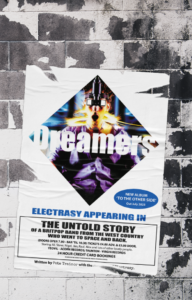Jukebox Time recently got a chance to interview Pete Trainor, author of Electrasy: Calling All The Dreamers. We got insights into his book, the band Electrasy, the revolutionaries, the renegades, their fans, and a journey into space and back via piracy, authenticity, and the collapse of the music industry!
Q. Welcome to Jukebox Time! Electrasy clearly had a major impact during the Britpop era. What inspired you to chronicle their journey in this detailed scrapbook biography?
I grew up in the same area of the Southwest of England that some of the band also came from. They drove a really positive vibe throughout our little town in the mid-90s and inspired many of us teenagers to not only stay off the streets and get into music, but they provided us with a real sense that we could do something more with our lives and leave if we wanted too. It sounds really cheesy, but that was incredibly powerful. They were producing phenomenal music and live shows on the local scene, but there was genuine awe about their work ethic and sense of vision. A lot of this is talked about at the start of the book. We really only had two sets of musical superheroes: PJ Harvey, and our very own bunch of renegade avengers, Electrasy.
The next strand of the book focuses a lot on how our paths re-crossed. I left Somerset and found a career in tech innovation, data, and human behaviour. In 2008, towards the back end of the music piracy era, I helped set-up a music streaming platform and when the catalogs started come in from the major labels I went hunting for Electrasys music, but it wasn’t there. That turned into a bit of a mission for me; What happened to the band, and their amazing debut album called ‘Beautiful Insane’? Both of which seemed to vanish off the face of the planet.
The book is a lot about myself, and the band getting closure on those journeys.
Q. As a fan-turned-insider, how did your relationship with the band evolve, and how did it influence the way you approached this book?
Such a good question. It evolved through our shared love of their music. When I first started chatting with Steve Atkins the Guitar Player from the band we clearly had a common interest in both the technology behind the music industry, but also the issues that plagued musicians when the world moved from analog to digital. We chatted a lot about how streaming services created a culture of disposable music, where listeners stopped appreciating the depth and craftsmanship of an album, which really spoke to me a lot because I’d been one of the early technologists essentially pushing the agenda of streaming music forward. In a funny sort of way, I’d evangelized this band in the 90s and then heavily contributed to the factors that wrecked them and many other bands later on. It caught me off guard a bit.
The culture of entitlement we created where listeners expect unlimited access to music for free totally undervalued musicians’ hard work and talent, and I wanted to also explore that with these childhood heroes of mine.
So we have three distinct strands to the book; My relationship with them, their journey from humble routes to conquering the U.S., and then eventually the technology thread that runs through the center of the whole piece that ultimately stopped them from being the band they could or should have been.
By the midway point of writing it with them from four different continents, we’d got into a really fun rhythm and the energy about the story was so positive it just flowed really naturally.
Q. The book provides a first-hand account of the band’s evolution. What was the most surprising revelation you encountered during your interviews with the band members?
Oh, so many revelations. Let me flip my response a bit; How incredible is it that a fan can get access to all the materials that only members of the band are usually privy too. I was given notebooks where we found early sketches and notes for songs. We found old setlists and demos they’d recorded, and I was even given an old notebook where we found the lists of band-names they’d brainstormed together before deciding on Electrasy.
There were a lot of industry stories and behind the scenes anecdotes that are hilarious, emotional, and revealing in equal measure. I can’t say too much because it would ruin the book, but I can say the band and a lot of the people around them throughout their career were all really honest, and candid, and helped craft something very special with me.
Q. Could you share one of the most memorable “Did that really happen?!” moments from the book without giving too much away
HA! Well OK, just one. There’s a very very funny story about an incident at a gig in San Luis Obispo, California that involves mushrooms, playing billiards, and a letter that got sent back to the UK that someone must have been humiliated to receive. That’s all I can say.
Q. In the process of curating the never-before-seen photos, did any particular image stand out or capture the essence of the band’s journey for you?
So many. Steve has literally collected boxes of photos, newspaper articles, interviews and recordings, and we spent a long time going through them picking the ones for the book.
I have the advantage of working in an area of technology and transformation that utilizes a lot of emerging Ai techniques, and we used some very clever Ai on old photos to restore them to modern glory. For the band’s biggest commercial hit, Morning Afterglow, in 1998 they made a stunning video where Ali the lead singer had to sing the entire song backwards, whilst destroying a room. When the video was played in reverse it looked like he was essentially putting the room back together. Hugely innovative for the time it was made. He even had to shoot it in one take. I was able to take very pixelated stills from the 90s camera equipment and upscale them to HD for the book. A true piece of restoration of a moment in pop history. I’m really proud we could do that for some of this stuff.
The pictures throughout the entire book from start to finish are really the story of the band’s essence. There’s probably no one image that means more than the others in that sense. They’re all part of the arc from then to now.
Q. The book doesn’t just focus on the band’s rise but also on the tumultuous music industry. What challenges did bands like Electrasy face during the 1990s and early 2000s, and how did it shape their trajectory?
We covered some of that earlier in the interview, but really what happened was Napster, LimeWire, and BitTorrent absolutely shredded all bands’ incomes from music sales to bits. The industry didn’t know how to deal with it, and kind of let it happen for so long that the monster was already out of the cage and when they shut one down, another one grew in its place. Bands like Electrasy were caught in the wake of the labels flapping and panicking and just as their star was rising over the global horizon they became effectively part of the label cost-cutting exercise and dropped. Twice in fact.
I think was fascinating and heartbreaking was listening to the members of the band recount what all this meant to them both personally and professionally. They weren’t an overnight success, they’d grafted for 5 years as a band to get to the U.S deal and been in bands growing up before that. So for it all to get tugged away because of industry bureaucracy was devasting for them, and many many other bands.
Q. Many bands from the 1990s faced both electrifying highs and crushing lows. How did the members of Electrasy cope with the pressures and challenges of rapid fame?
I don’t think I’ve ever met a more humble, grounded, and genuinely realistic bunch of people. And not just the band members, but some of the other people I met and interviewed from collaborating artists like Roni Blue, to their early producer Jon Sweet. That’s really their superpower in my opinion; They never really stopped being who they were when they were just a band from the deep Southwest of England doing pub gigs. They just did it on bigger stages, and to hundreds of thousands of people all over the world. They stuck together most of the time, and kept getting up when they were knocked down. But ultimately you can only do that so many times.
Also, I don’t think their fame was rapid per se. They’d carved out a huge local, grassroots following in 1998 performing over 180 shows throughout that breakthrough year. It was back-breaking work before they really hit the big-time and performed at Glastonbury in 1999.
Q. The title suggests a disruption of the music scene by Electrasy. In what ways did they challenge or change the norms of the industry?
If you can find it, you only have to listen to their elusive debut album called ‘Beautiful Insane’. This is a band that zigged when the industry wanted them to zag. It’s a ridiculous album in some ways, and an absolute masterpiece in others. We explored the journey of that album a lot in the first half of the book. It caused the industry executives managing them a huge headache at the time because they expected a sweeping pop opus, and got something often experimental and almost Pink Floyd-esque.
Most of the record executives from the time I approached for comment refused to speak to me, which screams volumes.
It was this experimentation which also ended up catching the eye of visionary industry veteran, Clive Davis of Arista fame, and why they ended up being exported to the U.S.
Q. During your research, did you come across any encounters with music royalty that particularly astonished or amused you?
We’re all friends now, so they’ll find it weird me saying this, but to me the band are music royalty in my eyes. Their new album entitled ‘To The Other Side’ which was released in May 2023 is proof of their caliber, it’s absolutely untouchable as a body of work.
Aside from the band it meant so much to me to be able to meet and speak to Jon Sweet the man who produced those early demos with the band in a garage in Yeovil, Somerset. Honestly, what an honor. He did more the local music scene when we were growing up than I think he probably realizes, and there I was chatting away with him reminiscing on stories that he’s also let me include in the book.
Q. Finally, in an era of digitized music and streaming platforms, how do you think Electrasy would fare if they were emerging today, given the insights you’ve gathered about the music industry’s evolution?
They can’t. Not many bands can. The music industry is a hollow promise of riches and fame that a very tiny crop of manufactured groups really get the backing to capitalize on. Apps like Shazam fed a lot of data back to the industry about what was deemed to be ‘popular’ and money was thrown at amplifying the trends, rather than the outliners and fringe artists. It’s still happening now. Electrasy as a band can’t make enough from all their albums, and singles to even fund a proper tour because of streaming payback, which is the catch-22 because you need to tour to gain popularity, but you can’t tour if your music is making enough to fund the tour. It’s why the big artists keep getting bigger, whilst the small indie groups are barely able to pay their bills and we seeing rising rates of mental health concerns, and unfortunate loss of life amongst the community of musicians out there. It can’t really go on like that for much longer, it’s time companies like Apple, Google and Spotify payed up and let arts flourish again.
Let me illustrate my point by leaving you with this. 1 stream on YouTube earns an artist c$0.00069. That’s $690 for 1 million listens of a song. Spotify reward their content providers like Electrasy with $0.00437 per stream. $4370 for a million streams. Apple Music is $0.00735 and $7350, and Amazon is $0.00402 and therefore $4020 for a million streams. Make it make sense to bands like Electrasy? Because I can’t.
About the author: Pete Trainor has always been driven by a desire to innovate and push the boundaries of what is possible with modern technology. Renowned globally for creating emotional experiences that transport audiences to interesting new worlds and time periods. With a focus on AI, automation and data, Pete is deeply committed to making a positive impact in the world. As a published author and speaker, Pete invites his audience to contemplate the power of technology to solve some of the world’s greatest challenges and how to find future solutions that can make a difference.
Electrasy: Calling All The Dreamers follows his own journey with a local band from the South West of England in the late 90s, exploring how technology ultimately made them, and then broke them.
The book is now available on Amazon!






